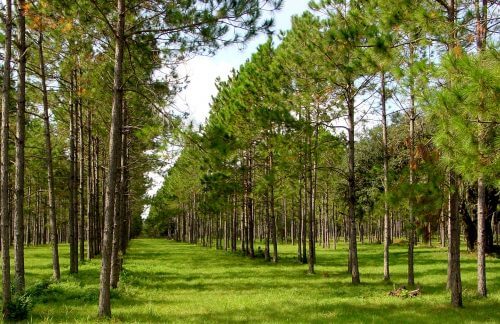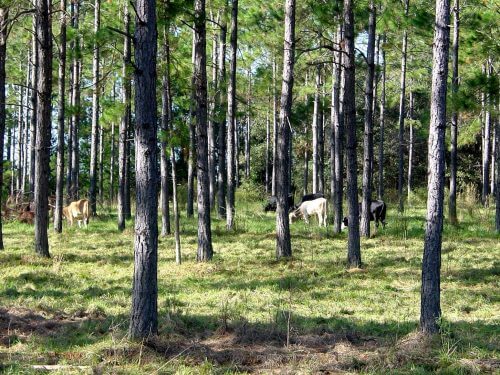Planting trees in agricultural fields ("Agroforestry" has a double advantage: in the fight against global warming and in helping farmers

The mitigation of global warming and climate change is becoming more and more urgent, therefore it is appropriate and correct to adopt proven initiatives, one of which is "forestry agriculture". Planting trees in cultivated areas, whether to shade coffee bushes, to shade herds in pastures, to grow fruit trees or useful trees in areas of millet, sorghum and other crops, in addition to the shade, the trees are an additional source of food, absorb more water and keep the soil free from silt. Trees add nutrients to the soil and above all trees absorb carbon.
According to The "Global Carbon Project" (Global Carbon Project), in 2017 there will be a two percent increase in DTP emissions. What constitutes a retreat from the downward trend in emissions in recent years. About a quarter of the emissions originate from agriculture and the conversion of forests and wetlands into farms. Added to this is the fact that 2017 is one of the hottest years in the last decade.
Floods in Southeast Asia, drought in East and South Africa, melting glaciers in Latin America, these are just examples of the extreme weather phenomena that affect every corner of the world and are related to global warming. In other words, the warming is already causing disasters all over the world.
Humanity has caused warming and climatic disasters and people have the power to moderate warming by reducing GHG emissions. And carbon absorption will increase through the protection of "carbon absorbers" such as forests.
A method for carbon absorption that is gaining recognition for its effectiveness is "forestry agriculture": renewal, planting and maintenance of trees and shrubs in agricultural and pasture areas.
Today there are about ten million square kilometers of agricultural fields where families maintain trees along with crops and grazing animals. More than a billion people subsist and depend on "forest-agriculture". The soil, the plants, and all the biomass in any such area absorb about 3,3 tons of D.T.F. Every year, much more of the same area without trees.
study It shows that when the world emits about 9.75 gigatons of DTP every year, the trees in agricultural areas absorb 0.75 gigatons of DTP. Every year.
On the carbon absorption of trees in agricultural and grazing areas, you can add benefits such as: fuel, fruits, oil, nuts, food for farm animals. Added to this is nitrogen fixation which enriches the soil and saves chemical fertilization. The trees fix nitrogen by absorbing it from the air and since nitrogen is a greenhouse gas, the profit is doubled. The presence of trees in agricultural areas improves the renewal and regulation of the water cycle and thus results in improved crops.

In addition to the global warming recession, "forest farming" helps farmers adapt to climate damage such as floods, droughts or irregular rains, since when the crops are damaged the trees in the field constitute an "iron ration" that allows the farmer to get through the difficult season and move on.
A study conducted in 2011 in western Kenya showed that "forest farming" improves the productivity of the area and thus the farmer's income while improving the environment.
Recently, the "forest-agriculture" method received recognition and even fame, when An international project of field research, describe the method as one of the solutions For the mitigation of global warming, a solution that is already being realized and if accepted on a large scale will reduce the level of D.T.F.
Also, pastures where trees are planted (Silvopastoralism) that increase carbon adsorption are described as being equally important for energy production from renewable sources.
Creating a canopy of tall trees above the "layers" (multistrata agroforestry) vegetation, such as coffee or cocoa, is customary and accepted in many areas.
Governments in "developing" countries are turning to "forestry agriculture" in the hope of improving the lives of farmers and at the same time responding to and supporting the "Paris Agreements" (Paris Agreement). Scientists have been aware of the benefits of "forest-agriculture" for several decades. Farmers have been aware of the benefits for much longer.
The method is indeed expanding, but when there are more than twenty million square kilometers of agricultural land, it is clear that the road is long.
When so many empty spaces are built, the risk to the climate and the soil increases. Without trees how will the underground water reservoirs be filled? How will the carbon be preserved in the soil? What will stop the landslide? Where will pollinating insects graze? There is a need for a wake-up call that will cause the understanding of the importance of trees in agricultural areas. "Forestry" is not a "money-slinger" but it has an important and essential role. To give farmers security against the dangers of the climate, to give the world a means to moderate global warming and climate change.

5 תגובות
Flooding the patient again might not be a bad starting idea at all
In the picture you see cows grazing in a grove of pine trees
The pine is a tree that interferes with the development of herbaceous plants under it.
Nor does it provide food security for humans
to Aviel,
In the past I already wrote that "end of response in reading comprehension",
It turns out that there are those who may understand only a part and do not bother to read the sources,
Because the claim "looks like a Google Translate translation." is just gibberish
So is the claim: "Writing of many unprocessed data",
This is also due to the fact that the commenter did not bother to read any of the sources
that are specified in the body of the list and from which the data was taken.
It is true that "there is no excess water in Israel" and this is a good reason to treat the method positively
But again, if the commenter had bothered to read, he would have noticed
Because the list mostly deals with developing countries,
Stiff?
Writing a lot of unprocessed data.
That is, it looks like a Google Translate translation.
There is no excess water in Israel, therefore, the addition of trees to areas with low vegetation.
If you want shade, build mesh houses.
In young plantations there are cover plants against evil doing such as oats between the regiments on which the trees are planted
good week.
A very interesting article. I hope Israel will also wake up and start changing things and push forward projects of this type